 Open Access Article
Open Access ArticleCreative Commons Attribution 3.0 Unported Licence
A happy medium: the synthesis of medicinally important medium-sized rings via ring expansion
Aimee K.
Clarke
and
William P.
Unsworth
 *
*
Department of Chemistry, University of York, York, YO10 5DD, UK. E-mail: william.unsworth@york.ac.uk
First published on 2nd March 2020
Abstract
Medium-sized rings have much promise in medicinal chemistry, but are difficult to make using direct cyclisation methods. In this minireview, we highlight the value of ring expansion strategies to address this long-standing synthetic challenge. We have drawn on recent progress (post 2013) to highlight the key reaction design features that enable successful ‘normal-to-medium’ ring expansion for the synthesis of these medicinally important molecular frameworks, that are currently under-represented in compound screening collections and marketed drugs in view of their challenging syntheses.
Introduction
Medium-sized rings are commonly found in diverse bioactive natural products and therapeutically important molecules (e.g.1–6, Fig. 1a).1,2 Distinct from normal-sized rings (5–7-membered) and macrocycles (12+ membered rings),3 the relative rigidity and diverse 3D spatial properties of medium-sized (8–11-membered) rings often results in improved binding affinity to biological receptors, oral bioavailability and cell permeability, compared with analogous acyclic molecules or other rings sizes.4 These attractive features have helped drive a real surge in interest in both the synthesis and applications of medium-sized rings and macrocycles for medicinal purposes,1–4 both within academia and the pharmaceutical industry. | ||
| Fig. 1 (a) Bioactive medium-sized rings. (b) Kinetic benefits of ring expansion compared with direct cyclisation. | ||
However, despite their promise, medium-sized rings are underrepresented in marketed drugs and drug discovery programmes, largely due to the well-known challenge of making them.5 Medium-sized rings occupy a somewhat unfortunate space synthetically, where the kinetic and thermodynamic barriers associated with their synthesis are typically higher than for other rings sizes; i.e. they are sufficiently large that synthesis via cyclisation of a linear precursor is often associated with significant loss of entropy, but small enough to experience destabilising transannular interactions and strain.6
Understanding these thermodynamic challenges is crucial when designing new strategies to make medium-sized rings. One strategy is to ‘grow’ medium-sized rings via ring expansion reactions,7 which means that the kinetic challenges associated with direct cyclisation approaches (e.g. metathesis, acylation, cycloaddition etc.)8 can be avoided (see Fig. 1b for a stylised reaction coordinate comparing the two scenarios). However, for such approaches to be successful, it is vital that the reaction is designed in such a way as to provide a clear thermodynamic imperative for rearrangement to occur; based on ring size alone, the conversion of normal- into medium-sized rings is usually always ‘uphill’ thermodynamically,6 thus, for ring expansion reactions to be exergonic overall, this thermodynamic cost must be ‘repaid’ via some other means.
The most common ways that this can be achieved are summarised in this minireview, in which we have particularly focused on exemplifying the key design features that drive the successful outcomes. Of course, it has been known for decades that ring expansion can be a powerful tool for the synthesis of medium-sized rings (and macrocycles), with the eponymous reactions developed by Grob and Eschenmoser,7e–g and the many important works of Manfred Hesse,7b,7h–k being especially noteworthy. These seminal studies and others have featured in various previous review articles,7a–c therefore, in this minireview, it was decided to focus on more recent (post 2013) state-of-the-art ring expansion methods for the synthesis of medium-sized rings. The material in this minireview is separated into 5 main sections (A–E) based on the thermodynamic features that help drive ring expansion. It is not intended to provide a comprehensive coverage, but rather, provide a balanced summary of recent methods that best exemplify each of the key thermodynamic driving forces. To provide a simple, easy to visualise representation of the reaction scope with respect to ring size, the ring sizes accessed to date using each method are highlighted (light blue).
(A) Bond dissociation energies
Many successful ring expansion reactions are driven by favourable changes in the overall bonding in the ring expanded products compared to the respective starting material(s); i.e. by using chemical energy contained within relatively reactive functional groups to promote ring expansion via conversion into more thermodynamically stable species (e.g. amides – as is demonstrated in all four reactions highlighted in this section). An instructive example of this approach is found in a 2017 report by Ye and co-workers,9a who reported an efficient yttrium-catalysed intramolecular hydroalkoxylation/Claisen rearrangement sequence to access a range of medium-sized lactams in good to excellent yields (7 → 9, Scheme 1a). The authors propose that π-acid activation of ynamide alkyne 7 promotes the formation of a reactive intermediate 8, which then undergoes a [3,3]-sigmatropic rearrangement9 to furnish ring expanded products 9. The formation of a strong C![[double bond, length as m-dash]](https://www.rsc.org/images/entities/char_e001.gif) O (amide) bond in lactams 9 presumably helps the ring expansion to proceed.
O (amide) bond in lactams 9 presumably helps the ring expansion to proceed.
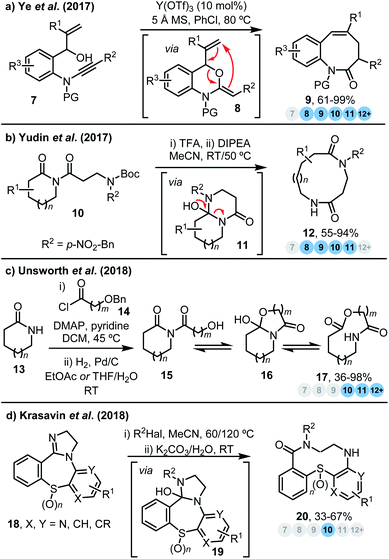 | ||
| Scheme 1 Ring expansion strategies driven by the formation of thermodynamically favourable bonds. (a) Ye et al.9a (b) Yudin et al.10 (c) Unsworth et al.11 (d) Krasavin et al.13b | ||
Amide formation is also an important driving force for ring expansion in a protocol reported by Yudin and co-workers,10 whereby a range of β-amino imides 10 can be converted into their corresponding bis lactams 12via the expansion of cyclol intermediates 11 (Scheme 1b). In the same study, the conversion of 2,5-diketopiperazines into cyclic tripeptides is also reported (not shown). Computational (DFT) analysis of the isomers involved in the key rearrangement step was performed, and the importance of relative energies of each species in the ring expansion equilibrium is demonstrated by the observation that conversion into the ring expanded product (e.g.12) only occurs successfully if this product is ‘exergonic by at least 6–12 kcal mol−1’, when compared to the cyclol intermediate (e.g.11).
The importance of the relative energies of isomeric species was also noted in a conceptually related ring expansion process from our own laboratory, in which imides can be converted into ring expanded lactones (15 → 16 → 17, Scheme 1c),11 with this work being part of a wider programme of research on lactam/lactone synthesis using Successive Ring Expansion (SuRE) reactions.12 As was the case in Yudin's study,10 ring size was pivotal in determining the reaction outcome, with ring expansion only viable for the synthesis of lactones above a certain ring size. The reactions were also studied using DFT, the results of which fully support the notion that these ring expansion reactions are under thermodynamic control; indeed, this work is a useful illustration of the important role ring size plays in influencing the thermodynamic outcomes of ring expansion reactions more broadly.
Krasavin et al. reported the hydrolytic imidazoline ring expansion (HIRE) of thiazepines and their derivatives, that enables the facile formation of medium-sized thiadiazecines (Scheme 1d).13a The reaction proceeds via initial activation of the 2-imidazoline moiety by N-alkylation, to generate an imidazolinium salt, which promotes nucleophilic attack by water to form a cyclol intermediate 19 under basic conditions. This species then undergoes ring expansion to form products 20, in analogy to Yudin's and our own methods.10–12 The same group also extended this work to prepare a range of similar medium-sized rings via a side-chain insertion ring expansion methodology proceeding via the same type of hydrated cyclol intermediates (cf.19) as seen in their previous work.13b,14
(B) Charged intermediates
The neutralisation or stabilisation of charged reactive intermediates can also serve as a driving force for ring expansion. In 2016, Clayden and co-workers reported a migratory ring expansion methodology through deprotonation of benzylic urea derivatives 21 to rapidly generate complex 8–12-membered benzodiazepines, benzodiazocines and their homologues 24 (Scheme 2a).15a Here, the n → n + 3 ring expansion benefits from the stabilisation of a negative charge, as reactive carbanion 22 rearranges into the comparatively stabilised urea anion 23. The same group also reported the use of an unconventional variant of the Smiles rearrangement to generate medium-sized rings 26 from benzo-fused nitrogen heterocycles 25 (Scheme 2b) via an n → n + 4 ring expansion,15b which also benefits from anion stabilisation during the ring expansion step.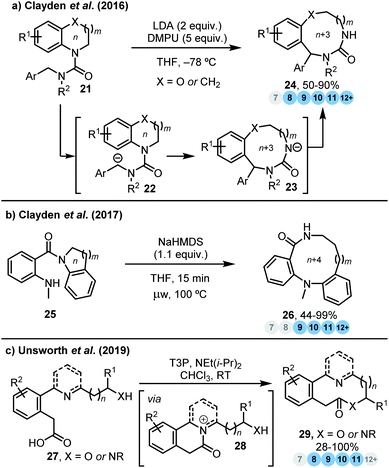 | ||
| Scheme 2 Ring expansion strategies driven by the neutralisation or stabilisation of charged reactive intermediates. (a) Clayden et al.15a (b) Clayden et al.15b (c) Unsworth et al.16a | ||
More recently, our group developed a cyclisation/ring expansion cascade process16a facilitated by an internal nucleophilic catalyst, to furnish medium-sized lactams and lactones directly from linear precursors (Scheme 2c).16 A key feature of these cascades is that they proceed exclusively via ‘normal’-sized cyclic transition states, and avoid medium-sized transition states. It is proposed that following activation of the carboxylic acid, a tertiary amine strategically placed within the linear starting material 27, acts as an internal nucleophilic catalyst, resulting in the rapid formation of an acyl ammonium ion intermediate 28. This intermediate is not observed, but rather undergoes spontaneous ring expansion, to deliver the final ring expanded lactone/lactam products 29. Neutralisation of the positive charge in 28 presumably plays a key role in providing a thermodynamic driving force for the normal-to-medium-sized rearrangement (8–11-membered rings can all be made using this method).
(C) Aromatisation
Ring expansion reactions can also be promoted by the formation (or re-formation) of stable aromatic products. Tan and co-workers developed a biomimetic diversity-oriented synthesis of benzannulated medium-sized rings via oxidative dearomatisation ring expansion (ODRE) of phenols (Scheme 3a).17a Initial oxidative dearomatisation of phenols 30 affords polycyclic cyclohexadienone intermediates 31 that undergo aromatisation-driven ring expansion, to deliver a variety of medium-sized ring scaffolds 32 found in natural products. The reaction can be induced by three complementary reagents (TsOH, Cu(BF4)2 or Tf2O) that avoid competing dienone–phenol rearrangements, although sometimes olefin isomers and solvent adducts can arise from other termination pathways. To overcome these limitations, the same group later reported an improved tandem ODRE reaction that utilises a novel Umpolung approach, whereby the initial oxidative dearomatisation proceeds via attack of an electron-rich aromatic onto an electrophilic side chain (Scheme 3b).17b This adaptation enabled the use of a wider range of non-phenolic substrates and heteroaromatics (not shown), and also enables some of the previously reported unwanted termination pathways to be avoided, thus leading to the formation of ketone products 34. Rearomatisation of the initially oxidised moiety in the ring expansion step is likely to play a key part in both transformations, with each having demonstrable potential for the exploration of 3D drug-like space.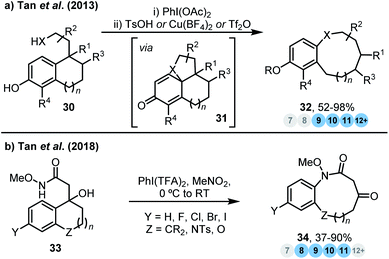 | ||
| Scheme 3 Ring expansion strategies promoted by the formation of stable aromatic products. (a) Tan et al.17a (b) Tan et al.17b | ||
(D) Ring strain
Relief of ring strain (especially in 4-membered rings) can also be used to drive ring expansion reactions. In 2015, Sun and co-workers reported an efficient catalytic ring expansion procedure using N-sulfonyliminiums 35 and siloxy alkynes 36 to prepare a range of medium-sized lactams 38 (Scheme 4a).18 The authors propose that the reaction proceeds via initial acid-catalysed activation of N-sulfonyliminium 35via loss of a water/alcohol leaving group, to generate an iminium species that goes on to react with siloxy alkyne 36 to furnish azetidinium 37. This strained (and charged) reactive intermediate is then primed to undergo ring expansion, thereby releasing ring strain and delivering the desired ring expanded products 38.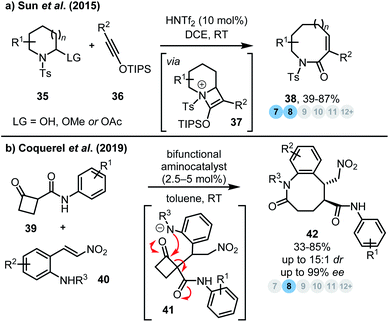 | ||
| Scheme 4 Ring expansion strategies driven by the relief of ring strain. (a) Sun et al.18 (b) Coquerel et al.19 | ||
Most organocatalytic cascade reactions focus on the preparation of more energetically favourable 5- and 6-membered rings; however Coquerel et al. devised an innovative enantioselective organocatalytic synthesis of benzazocinones 42 based on a Michael addition-4-atom ring expansion cascade from activated cyclobutanones 39 and ortho-amino nitrostyrene derivatives 40 (Scheme 4b).19 Relief of ring strain means that even relatively stabilised anilide nucleophiles are sufficiently reactive to promote effective 4- to 8-membered ring expansion, via cyclobutanone intermediates of the form 41.
(E) Radical stability
Radical reactions are also powerful tools for the synthesis of medium-sized rings via ring expansion. These reactions are typically driven by an increase in radical stability during the key ring expansion step, with several reaction classes that well illustrate this point having been reported recently by Liu et al.20 For example, in 2016, this group applied a radical-mediated ring expansion approach in the construction of various benzannulated medium-sized rings (Scheme 5a).20a Addition of a range of electrophilic radicals to the alkene moiety of rationally designed alkenyl cyclic α-hydroxyketones 43 triggers ring expansion by a remote 1,4- or 1,5-carbonyl migration process to furnish 9-, 10- and 11-membered rings 45. The formation of a relatively stable tertiary ketyl radical from a much less stable alkoxy radical 44 is a key driving force for this impressive ring expansion reaction. The same team also reported a novel diversity-oriented synthesis of diverse benzannulated medium-sized rings via a conceptually related approach (Scheme 5b).20b Again, formation of a relatively stable neutral ketyl radical (from dearomatised radical species 47) presumably provides a strong driving force for ring expansion. DFT calculations were performed as part of this study, and notable points include: (a) overall the sequential cascade is exothermic by 2.0 kcal mol−1 and (b) the presence of an OH group as a π-donating moiety significantly stabilises the resultant ketyl radical species.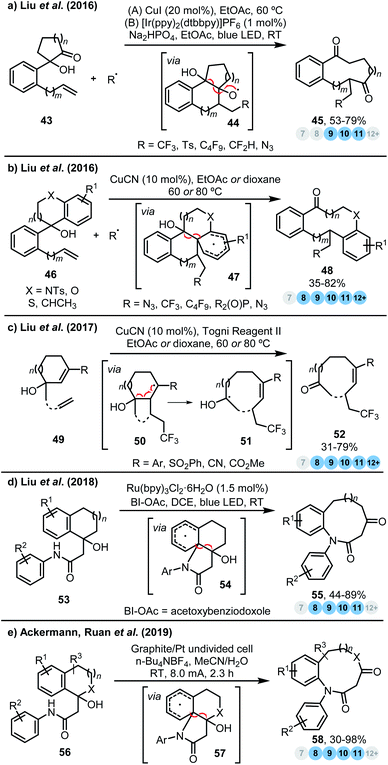 | ||
| Scheme 5 Ring expansion strategies driven by an increase in radical stability. (a) Liu et al.20b (b) Liu et al.20b (c) Liu et al.20c (d) Liu et al.20d (e) Ackermann, Ruan et al.21 | ||
In 2017, the Liu group reported a novel C–C bond reorganisation strategy via an unprecedented radical 1,3-, 1,4- or 1,5-vinyl migration (Scheme 5c).20c Their strategy provides access to a diverse range of fluoroalkyl-containing medium- and large-sized cyclic alkenes 52 (only CF3 radical addition products are shown) with excellent chemo-, regio-, and stereoselectivity; the selectivity observed here is particularly impressive given that two alkenyl groups are present in the starting cyclic alkenol substrates 49. The authors propose that the reaction proceeds via selective radical attack at the least sterically hindered terminal alkene to provide a transient alkyl radical which then undergoes exo cyclisation to afford radical 50. Subsequent β-scission and vinyl migration/ring expansion delivers the fluoroalkylated medium-/large-sized cyclic alkenes 52 which is again driven by the formation of another lower-energy neutral ketyl radical 51.
Most recently, the same group also developed an efficient photocatalytic n + 3 ring expansion strategy that provides convenient access to 8–11-membered lactams from readily available cyclic aryl ketones 53. This variant operates via initial generation of a nitrogen centred radical, using visible-light photoredox catalysis (Scheme 5d).20d The procedure, which employs a ruthenium-based redox catalyst and acetoxybenziodoxole as an oxidant, exhibits broad scope and the authors were also able to prepare 13–15-membered macrolactams using an n → n + 4 variant. Although not explicitly mentioned, it is again likely that the driving force of this reaction is the formation of a neutral ketyl radical species 54.
Finally, Ruan, Ackermann and co-workers reported a catalyst-free, electrochemical variant of this process, which also proceeds via a neutral ketyl radical species 57, including heteroaryl substrates (not shown) and heteroatom tethered species (Scheme 5e).21
Conclusions
The development of any chemical process involving internal rearrangement reactions can be challenging – especially so when the steps have the potential to be reversible. Arguably, these challenges are particularly acute for ring expansion reactions involving the conversion of normal- to medium-sized rings, in view of the thermodynamic penalties often associated with this change in ring size. In this minireview, we have tried to highlight a representative selection of the best and most creative modern methods for the synthesis of medium-sized rings via ring expansion methods. In particular, we were keen to place special focus on how the key design aspects of the reactions featured enable the kinetic and thermodynamic challenges associated with medium-sized ring formation to be overcome. Interest in medium-sized rings (and larger ring systems more broadly) in applied fields has undoubtedly increased dramatically in recent years, especially in medicinal chemistry.4 As demand for functionalised medium-sized rings grows, so does the need to develop new ways to prepare them, using predictable, practical and scalable methods. We propose that well-designed ring expansion reactions of the type featured in this minireview, are ideally placed to answer this call.Conflicts of interest
There are no conflicts to declare.Acknowledgements
The authors would like to thank the EPSRC for funding (A. K. C. EP/R013748/1) and the Department of Chemistry, University of York, for the provision of an Eleanor Dodson Fellowship (to W. P. U.).Notes and references
- A. Hussain, S. K. Yousuf and D. Mukherjeem, RSC Adv., 2014, 4, 43241 RSC.
- (a) B. Kunze, R. Jansen, F. Sasse, G. Höfle and H. Reichenbach, J. Antibiot., 1998, 51, 1075 CrossRef CAS; (b) A. Evidente, R. Lanzetta, R. Capasso, M. Vurro and A. Bottalico, Phytochemistry, 1993, 34, 999 CrossRef CAS; (c) K. M. George, M.-C. Frantz, K. Bravo-Altamirano, C. R. LaValle, M. Tandon, S. Leimgruber, E. R. Sharlow, J. S. Lazo, Q. J. Wang and P. Wipf, Pharmacuetics, 2011, 3, 186 CrossRef CAS; (d) K. Sumi, Y. Inoue, M. Nishio, Y. Naito, T. Hosoya, M. Suzuki and H. Hidaka, Bioorg. Med. Chem. Lett., 2014, 24, 831 CrossRef CAS PubMed.
- For macrocycles in medicinal chemistry, see: (a) E. M. Driggers, S. P. Hale, J. Lee and N. K. Terrett, Nat. Rev. Drug Discovery, 2008, 7, 608 CrossRef CAS PubMed; (b) E. Marsault and M. L. Peterson, J. Med. Chem., 2011, 54, 1961 CrossRef CAS PubMed; (c) F. Giordanetto and J. Kihlberg, J. Med. Chem., 2014, 57, 278 CrossRef CAS PubMed; (d) A. K. Yudin, Chem. Sci., 2015, 6, 30 RSC; (e) M. D. Cummings and S. Sekharan, J. Med. Chem., 2019, 62, 6843 CrossRef CAS PubMed.
- For medium-sized rings in medicinal chemistry, see: (a) K. R. Romines, K. D. Watenpaugh, P. K. Tomich, W. J. Howe, J. K. Morris, K. D. Lovasz, A. M. Mulichak, B. C. Finze, J. C. Lynn, M.-M. Horng, F. J. Schwende, M. J. Ruwart, G. L. Zipp, K.-T. Chong, L. A. Dolak, L. N. Toth, G. M. Howard, B. D. Rush, K. F. Wilkinson, P. L. Possert, R. J. Dalga and R. R. Hinshaw, J. Med. Chem., 1995, 38, 1884 CrossRef CAS PubMed; (b) T. P. Majhi, B. Achari and P. Chattopadhyay, Heterocycles, 2007, 71, 1011 CrossRef CAS; (c) F. Kopp, C. F. Stratton, L. B. Akella and D. S. Tan, Nat. Chem. Biol., 2012, 8, 358 CrossRef CAS PubMed; (d) R. A. Bauer, T. A. Wenderski and D. S. Tan, Nat. Chem. Biol., 2013, 9, 21 CrossRef CAS PubMed; (e) C. Zhao, Z. Ye, Z.-X. Ma, S. A. Wildman, S. A. Blaszczyk, L. Hu, I. A. Guizei and W. Tang, Nat. Commun., 2019, 10, 4015, DOI:10.1038/s41467-019-11976-2.
- (a) M. A. Casadei, C. Galli and L. Mandolini, J. Am. Chem. Soc., 1984, 106, 1051 CrossRef CAS; (b) K. C. Majumdar, RSC Adv., 2011, 1, 1152 RSC; (c) A. Sharma, P. Appukkuttan and E. Van der Eycken, Chem. Commun., 2012, 48, 1623 RSC For relevant information on the challenge of larger ring synthesis more focused on macrocycles, see: (d) J. Fastrez, J. Phys. Chem., 1989, 93, 2635 CrossRef CAS; (e) J. C. Collins and K. James, MedChemComm, 2012, 3, 1489 RSC; (f) H. Kurouchi and T. Ohwada, J. Org. Chem., 2020, 85, 876 CrossRef CAS PubMed.
- G. Illuminati and L. Mandolini, Acc. Chem. Res., 1981, 14, 95 CrossRef CAS.
- For reviews of ring expansion chemistry, see: (a) M. Hesse, in Ring Enlargement in Organic Chemistry, Wiley-VCH, Weinheim, 1991 Search PubMed; (b) W. P. Unsworth and J. R. Donald, Chem.–Eur. J., 2017, 23, 8780 CrossRef PubMed; (c) K. Prantz and J. Mulzer, Chem. Rev., 2010, 110, 3741 CrossRef CAS PubMed; (d) T. C. Stephens and W. P. Unsworth, Synlett, 2020, 31, 133 CrossRef CASFor seminal methods, see: (e) A. Eschenmoser and A. Frey, Helv. Chim. Acta, 1952, 35, 1660 CrossRef CAS; (f) C. A. Grob and W. Baumann, Helv. Chim. Acta, 1955, 38, 594 CrossRef CAS; (g) P. S. Wharton, J. Org. Chem., 1961, 26, 4781 CrossRef; (h) U. Kramer, A. Guggisberg, M. Hesse and H. Schmid, Angew. Chem., Int. Ed., 1977, 16, 861 CrossRef; (i) U. Kramer, A. Guggisberg, M. Hesse and H. Schmid, Helv. Chim. Acta, 1978, 61, 1342 CrossRef CAS; (j) R. Wälchli and M. Hesse, Helv. Chim. Acta, 1982, 65, 2299 CrossRef; (k) R. Wälchli, A. Guggisberg and M. Hesse, Helv. Chim. Acta, 1984, 67, 2178 CrossRef.
- For information on classical end-to-end cyclisation methods and other strategies to make medium-sized rings, see ref. 1 and 4a–e, and: (a) G. A. Molander, Acc. Chem. Res., 1998, 31, 603 CrossRef CAS; (b) L. Yet, Chem. Rev., 2000, 100, 2963 CrossRef CAS PubMed.
- (a) B. Zhou, L. Li, X. -Q. Zhu, J. -Z. Yan, Y. -L. Guo and L. -W. Ye, Angew. Chem., Int. Ed., 2017, 56, 4015 CrossRef CAS PubMed For related ring expansion methods to make medium-sized rings using 3,3-sigmatropic rearrangement, see: (b) X. Gao, M. Xia, C. Yuan, L. Zhou, W. Sun, C. Li, B. Wu, D. Zhu, C. Zhang, B. Zheng, D. Wang and H. Guo, ACS Catal., 2019, 9, 1645 CrossRef CAS; (c) H. Wu, W. Zi, G. Li, H. Lu and F. D. Toste, Angew. Chem., Int. Ed., 2015, 54, 8529 CrossRef CAS PubMedFor an interesting extension to this work based on 1,3-sigmatropic rearrangement, see: (d) B. Zhou, Y.-Q. Zhang, K. Zhang, M.-Y. Yang, Y.-B. Chen, Y. Li, Q. Peng, S.-F. Zhu, Q.-L. Zhou and L.-W. Ye, Nat. Commun., 2019, 10, 3234, DOI:10.1038/s41467-019-11245-2.
- R. Mendoza-Sanchez, V. B. Corless, Q. N. N. Nguyen, M. Bergeron-Brlek, J. Frost, S. Adachi, D. J. Tantillo and A. K. Yudin, Chem.–Eur. J., 2017, 23, 13319 CrossRef CAS PubMed.
- T. C. Stephens, A. Lawer, T. French and W. P. Unsworth, Chem.–Eur. J., 2018, 24, 13947 CrossRef CAS.
- (a) C. Kitsiou, J. J. Hindes, P. I'Anson, P. Jackson, T. C. Wilson, E. K. Daly, H. R. Felstead, P. Hearnshaw and W. P. Unsworth, Angew. Chem., Int. Ed., 2015, 54, 15794 CrossRef CAS; (b) L. G. Baud, M. A. Manning, H. L. Arkless, T. C. Stephens and W. P. Unsworth, Chem.–Eur. J., 2017, 23, 2225 CrossRef CAS; (c) T. C. Stephens, M. Lodi, A. Steer, Y. Lin, M. Gill and W. P. Unsworth, Chem.–Eur. J., 2017, 23, 13314 CrossRef CAS.
- (a) E. Reutskaya, A. Osipyan, A. Sapegin, A. S. Novikov and M. Krasavin, J. Org. Chem., 2019, 84, 1693 CrossRef CAS; (b) A. Osipyan, A. Sapegin, A. S. Novikov and M. Krasavin, J. Org. Chem., 2018, 83, 9707 CrossRef CAS PubMed.
- For seminal works that underpin much of the research in Section A, see ref. 7a for a review, and also: (a) R. Wälchli, A. Guggisberg and M. Hesse, Tetrahedron Lett., 1984, 21, 2205 CrossRef; (b) U. Kramer, A. Guggisberg, M. Hesse and H. Schmid, Angew. Chem., Int. Ed., 1978, 17, 200 CrossRef; (c) M. M. Shemyakin, V. K. Antonov, A. M. Shkrob, V. I. Shchelokov and Z. E. Agadzhanyan, Tetrahedron, 1965, 21, 3537 CrossRef CAS; (d) G. I. Glover, R. B. Smith and H. Rapoport, J. Am. Chem. Soc., 1965, 87, 2003 CrossRef CAS; (e) J. M. Muchowski, Can. J. Chem., 1970, 48, 1946 CrossRef CAS; (f) A. N. Chulin, I. L. Rodionov, L. K. Baidakova, L. N. Rodionova, T. A. Balashova and V. T. Ivanov, J. Pept. Sci., 2005, 11, 175 CrossRef CAS; (g) E. J. Corey, D. J. Brunelle and K. C. Nicolaou, J. Am. Chem. Soc., 1977, 99, 7359 CrossRef CAS; (h) G. H. Posner, M. A. Hatcher and W. A. Maio, Org. Lett., 2005, 7, 4301 CrossRef CAS PubMed; (i) R. C. Cookson and P. S. Ray, Tetrahedron Lett., 1982, 23, 3521 CrossRef CAS For more recent examples not covered in this minireview, see: (j) D. R. Loya, A. Jean, M. Cormier, C. Fressigné, S. Nejrotti, J. Blanchet, J. Maddaluno and M. De Paolis, Chem.–Eur. J., 2018, 24, 2080 CrossRef CAS PubMed; (k) A. Dierks, J. Tönjes, M. Schmidtmann and J. Christoffers, Chem.–Eur. J., 2019, 25, 14912 CrossRef CAS PubMed.
- (a) J. E. Hall, J. V. Matlock, J. W. Ward, K. V. Gray and J. Clayden, Angew. Chem., Int. Ed., 2016, 55, 11153 CrossRef CAS PubMed; (b) R. Costil, Q. Lefebvre and J. Clayden, Angew. Chem., Int. Ed., 2017, 56, 14602 CrossRef CAS PubMed.
- (a) A. Lawer, J. A. Rossi-Ashton, T. C. Stephens, B. J. Challis, R. G. Epton, J. M. Lynam and W. P. Unsworth, Angew. Chem., Int. Ed., 2019, 58, 13942 CrossRef CAS PubMed For conceptually related reactions involving cyclisation to a normal-sized ring reactive intermediate that subsequently undergoes ring expansion, see ref. 9a, c and: (b) O. Boyd, G.-W. Wang, O. O. Sokolova, A. D. J. Calow, S. M. Bertrand and J. F. Bower, Angew. Chem., Int. Ed., 2019, 58, 18844 CrossRef CAS PubMed.
- (a) R. A. Bauer, T. A. Wenderski and D. S. Tan, Nat. Chem. Biol., 2013, 9, 21 CrossRef CAS PubMed; (b) T. Guney, T. A. Wenderski, M. W. Boudreau and D. S. Tan, Chem.–Eur. J., 2018, 24, 13150 CrossRef CAS PubMed.
- W. Zhao, H. Qian, Z. Li and J. Sun, Angew. Chem., Int. Ed., 2015, 54, 10005 CrossRef CAS PubMed.
- Y. Zhou, Y.-L. Wei, J. Rodriguez and Y. Coquerel, Angew. Chem., Int. Ed., 2019, 58, 456 CrossRef CAS PubMed.
- (a) Z.-L. Li, X.-H. Li, N. Wang, N.-Y. Yang and X.-Y. Liu, Angew. Chem., Int. Ed., 2016, 55, 15100 CrossRef CAS PubMed; (b) L. Li, Z.-L. Li, F.-L. Wang, Z. Guo, Y.-F. Cheng, N. Wang, X.-W. Dong, C. Fang, J. Liu, C. Hou, B. Tan and X.-Y. Liu, Nat. Commun., 2016, 7, 13852, DOI:10.1038/ncomms13852; (c) L. Li, Z.-L. Li, Q.-S. Gu, N. Wang and X.-Y. Liu, Sci. Adv., 2017, 3, e1701487 CrossRef PubMed; (d) N. Wang, Q.-S. Gu, Z.-L. Li, Z. Li, Y.-L. Guo, Z. Guo and X.-Y. Liu, Angew. Chem., Int. Ed., 2018, 57, 14225 CrossRef CAS PubMed; (e) N. Wang, J. Wang, Y.-L. Guo, L. Li, Y. Sun, Z. Li, H.-X. Zhang, Z. Guo, Z.-L. Li and X.-Y. Liu, Chem. Commun., 2018, 54, 8885 RSC.
- Z. Xu, Z. Huang, Y. Li, R. Kuniyil, C. Zhang, L. Ackermann and Z. Ruan, Green Chem., 2020, 22, 1099 RSC.
| This journal is © The Royal Society of Chemistry 2020 |
